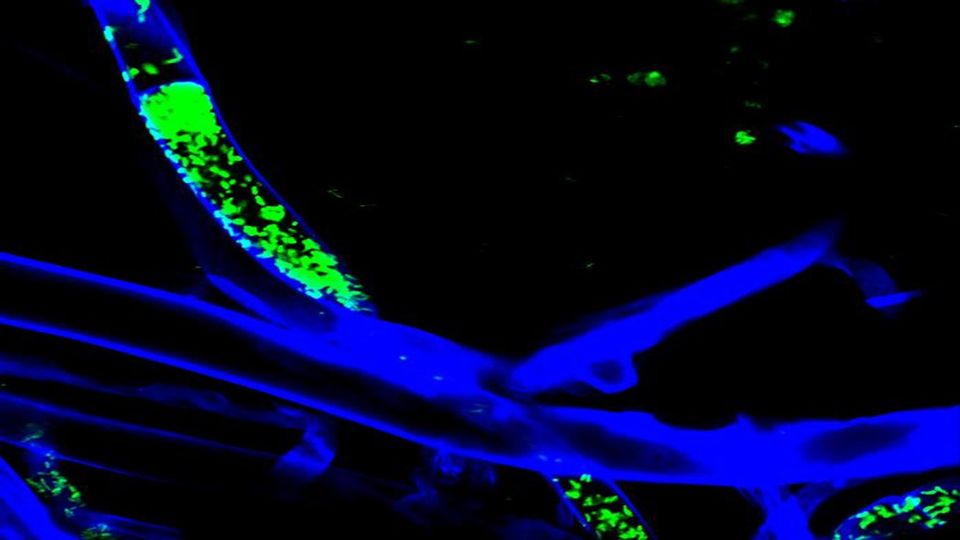[ad_1]
Published: July 5, 2023
| Original story from the Leibniz Institute for Natural Product Research and Infection Biology
The fluorescence image shows M. rhizoxinica bacteria (green) enclosed in parts of a fungal hyphal (blue). Credit: Ingrid Richter/Leibniz-HKI.Download Article
FacebookTwitterLinkedInRedditShare
A study on the coexistence of bacteria and fungi reveals that a fragile symbiotic relationship exists between Mycetohabitans rhizoxinica bacterium and Rhizopus microsporus fungus. The presence of a specific bacterial protein maintains the symbiosis, while its absence leads to a potentially parasitic interaction.
Key Takeaways
The bacterium Mycetohabitans rhizoxinica and the fungus Rhizopus microsporus form a symbiotic relationship, with the bacterium producing a plant toxin essential for the fungus to spread efficiently and the fungus providing nutrients to the bacterium.A specific bacterial protein called TAL effector 1 (MTAL1) is crucial for maintaining the symbiosis between the bacterium and the fungus.When the TAL effector protein is deactivated, the bacteria multiply uncontrollably, and the fungus responds by trapping and killing the bacteria, indicating a shift from a symbiotic relationship to a potentially parasitic one.
A new study on the coexistence of bacteria and fungi shows that a mutually beneficial, functioning symbiosis can be very fragile. Researchers at the Leibniz Institute for Natural Product Research and Infection Biology (Leibniz-HKI) in Jena found out that the bacterial species Mycetohabitans rhizoxinica lives happily in the hyphae of the fungus Rhizopus microsporus only when the bacteria produce a certain protein.
In a symbiosis, two organisms join together and benefit from each other; in endosymbiosis, one of the organisms takes this strategy further to live within the other. In some cases, they can’t do without each other, like the fungus Rhizopus microsporus and the bacterium Mycetohabitans rhizoxinica (previously known as (Para)burkholderia rhizoxinica). The fungus can cause rice seedling blight, which leads to enormous crop losses in Asia every year. However, R. microsporus can only do this with M. rhizoxinica: the bacterium produces a plant toxin that is processed and released by the fungus. Without the bacterium, the fungus can no longer form spores and spread efficiently. In return, it supplies its endosymbiont with nutrients.
“In the wild, the two always live in symbiosis,” explains Ingrid Richter, a postdoctoral researcher in the Department of Biomolecular Chemistry at Leibniz-HKI. In the laboratory, however, the researchers have succeeded in cultivating them separately. “As a result, we know that the bacteria are still able to infect the fungus,” Richter said.
From parasitism to symbiosis?
The research team now found that a specific bacterial protein, or more precisely an effector protein, maintains the symbiosis. If the researchers deactivate the so-called TAL effector 1 (MTAL1), the bacteria multiply uncontrollably, and the fungus, as a result, closes off parts of its hyphae with new cell walls. The now-trapped bacteria subsequently die. “These TAL effectors are known from various plant-infecting bacteria,” Richter said, where they allow the bacteria to invade plant cells.
The research results provide new insights into endosymbiotic partnerships that play a major role in evolution. For example, today’s mitochondria, the energy providers in plant, animal, and fungal cells, were probably originally endosymbionts. They have their own DNA, but have long been unable to survive independently – unlike M. rhizoxinica. “In addition, through close microscopic observation, we have learned quite a bit about what tasks different types of hyphae have in the fungal mycelium, for example, the transport of nutrients,” Richter explains.
Reference: Richter I, Wein P, Uzum Z, et al. Transcription activator-like effector protects bacterial endosymbionts from entrapment within fungal hyphae. Current Biology. 2023:S0960982223006231. doi: 10.1016/j.cub.2023.05.028
This article has been republished from the following materials. Article summaries may be generated using fact-checked AI models. Note: material may have been edited for length and content. For further information, please contact the cited source. Technology Networks
N
[ad_2]
